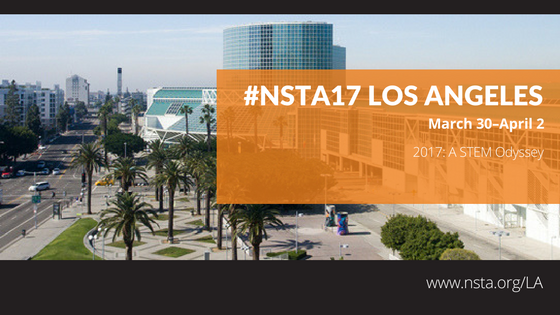Embark on Your STEM Odyssey in LA at #NSTA17
By Lauren Jonas, NSTA Assistant Executive Director
Posted on 2017-01-04
Editor’s Note: This blog originally listed the wrong featured speaker for this strand.
This spring, the National Science Teachers Association (NSTA) will feature a special strand “2017: A STEM Odyssey” at our 2017 National Conference on Science Education, in Los Angeles: March 30–April 2. Students’ science learning has changed dramatically from learning in the past. In a STEM environment, students’ understanding of the world around them is facilitated through the intentional connections between the four disciplines of science, technology, engineering, and mathematics. STEM curriculum provides research-based instructional strategies that engage diverse learners and highlights career pathways in STEM-related fields. More importantly, STEM provides opportunities for all students to place themselves in a 21st-century world. Participants will connect and collaborate to increase their understanding and ability to teach STEM-based lessons and instructional sequences.
The featured presentation for this strand will be announced soon!
Below is a small sampling of other sessions on this topic:
- Host a Rockstar Family STEM Event
- Incorporating Global STEM Collaboration into Your Classroom!
- Interactive Science Notebooks: Low-Tech Creations for Higher Level Thinking
- Bilingual Engineering Adventures for the Whole Family
- Using Robots to Teach Science, Math, Art, and Language Arts
- A STEM Approach to Integrate Drones as a Teaching and Technology Tool
- Early Elementary STEM Curriculum
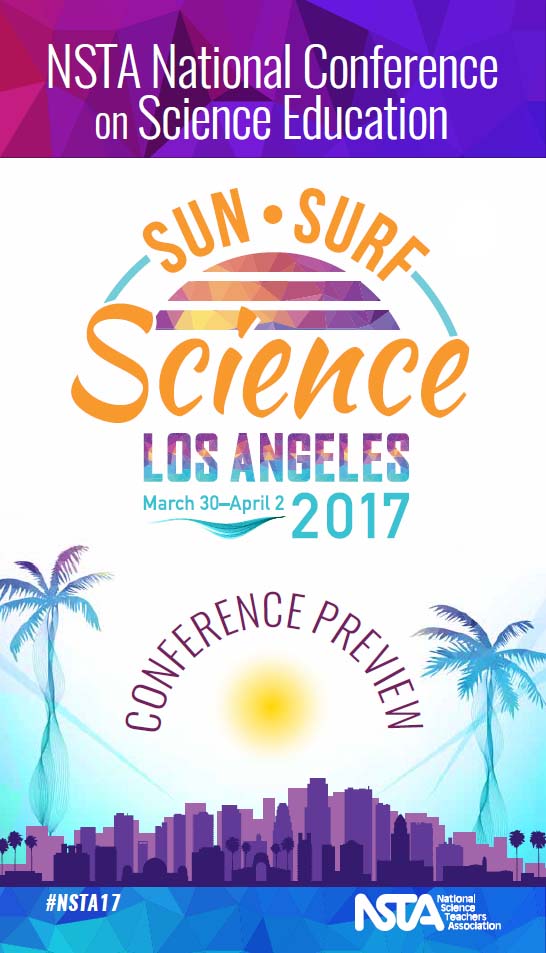 Want more? Browse the program preview, or check out more sessions and other events with the LA Session Browser/Personal Scheduler. Follow all our conference tweets using #NSTA17, and if you tweet, please feel free to tag us @NSTA so we see it! Need to request funding or time off? Download this letter of support.
Want more? Browse the program preview, or check out more sessions and other events with the LA Session Browser/Personal Scheduler. Follow all our conference tweets using #NSTA17, and if you tweet, please feel free to tag us @NSTA so we see it! Need to request funding or time off? Download this letter of support.
The mission of NSTA is to promote excellence and innovation in science teaching and learning for all.
Future NSTA Conferences
2017 National Conference
2017 STEM Forum & Expo
Follow NSTA
Resources and Human Impact
Engaging Students in the STEM Lab
By Debra Shapiro
Posted on 2017-01-02

In the STEM Lab at Englewood Middle School in Englewood, Colorado, eighth graders
discuss plans for building a quadcopter drone of their own design. Students in the
Englewood school district research the careers associated with each of their STEM Lab
projects. Photo by Bill Gilmore
Schools nationwide are adding STEM (science, technology, engineering, and math) Labs, spaces where students can apply science and math concepts. “We have two dedicated ‘STEM Labs’ spaces,” shared by two grade-level groups, K–4 and 5–8, says Jessica Boualavong, K–4 STEM teacher at Town School for Boys, an independent school in San Francisco. “For our STEM program, we integrate engineering projects and skills into traditionally science-based units,” she notes.
“One STEM lab is designed for heavy-duty prototyping and experimenting, [with] tool chests and large sinks for easy access and management of supplies and cleanup,” she explains. “It’s essential to have a very well-defined, student-accessible supply area for prototyping across subject areas.”
The second STEM lab “is a forum space with three projectors for…presentations, [where] students can show off their projects or participate in a videoconference,” she explains. This space has a smaller Maker Corner where students can do “open-ended tinkering and practice with tools and supplies,” she relates.
At Franklin Avenue Middle School in Franklin Lakes, New Jersey, STEM Education Teacher Eileen Antonison teaches a 45-day STEM Lab cycle class. “I developed and wrote the curriculum for my [grades 6–8] integrated STEM courses that are aligned to the full-year core science classes…I collaborate with the science teachers to make sure we’re supporting [one another]” and not assigning duplicate projects, she relates.
For example, seventh graders study life science in their science classes and “bioengineering—life science and environmental engineering,” in STEM Lab, she notes. In science, they study photosynthesis; in STEM Lab, they build, use, and collect data from photobioreactors, systems that use light to grow algae using only the photosynthetic mode of cultivation.
Some schools are adding STEAM (science, technology, engineering, arts, and math) Labs. “[W]e built brand-new [ones] in all five of our elementary school[s],” says Tara Kristoff, director of curriculum at Cook County School District 104 in Summit, Illinois, a K–8 school district with high percentages of English language learners and students living in poverty. STEAM classrooms “are state of the art with writable wall[s], windows, and furniture…[T]he furniture is movable to encourage collaboration and discussion,” she explains.
The curriculum delves “deeply into Next Generation Science Standards (NGSS) science and engineering instruction and assessment,” she asserts. For example, first graders learn in science class that waves make sound through a material. In STEAM Lab, they create their own drums using different materials and see which sounds they make, and draw the type of sound waves that match their drum’s sound. “Students see the connection of science to everything else in the world,” Kristoff contends.
General education teachers and STEAM teachers co-teach the class. “Many K–5 teachers in our district who [don’t] feel confident teaching science are becoming confident with the help and support of ” STEAM teachers, who have been trained “in the pedagogy shift of NGSS and truly embody the three dimensions in their teaching,” she maintains.
In group projects, students practice teamwork, compromise, and conflict resolution—“the skills to be the best STEM employee possible,” she asserts. “Most importantly, we have [groups] who have been historically [considered disinterested] in STEM thinking about [future STEM] careers.”
Focus on Careers
In the Powhatan County Public Schools district in Powhatan, Virginia, every school has a full-time STEM lead teacher, and “we have two full-time STEM coaches for our K–5 [STEM Lab] program” because “we believe by building interest early, our students will not only have a better understanding of the types of work people in STEM career fields do, but also they will be more likely to pursue STEM electives” and STEM careers, says Libbey Kitten, K–12 science/STEM curriculum specialist.
The program’s design was based on recommendations from a steering committee of parents, teachers, engineers, and representatives from local businesses. “We’re a small, semi-rural district with limited resources, but we have discovered that if you build it, and you have the support of your community, the money will come,” she relates.
STEM Lab teachers in Colorado’s Englewood School District are certified “through the Colorado Department of Education as CTE [Career and Technical Education] STEM teachers,” says Bill Gilmore, the district’s STEM coordinator and STEM coach. “We have STEM Labs in…our high schools, our middle school, and one elementary school. We hope to [expand to all elementary schools] and our preschool by fall 2017.”
STEM Labs “are stand-alone…classes at the middle school and high school level, and specials at the elementary level…We want these spaces to be places where students can be creative, collaborate, think outside of the traditional boxes, and fail in an environment where failure is expected and part of the process,” he maintains.
“We have three STEM pathways for K–12, based on Colorado’s economy: computer science; natural resources and energy; and engineering, robotics, and advanced manufacturing. In the STEM Lab, students are free to come up with ideas and apply them through a pathway, following the design process,” he explains. Students “explore careers related to their projects and connect their projects to their core classes.”
Providing Enrichment
Crocker High School in Crocker, Missouri, offers STEM Labs as enrichment, says science teacher Marteen Nolan. “Enrichment activities have proven to be strong incentives for our students,” she asserts. Students need “at least a C average and no Fs, 95% attendance,…and no written disciplines” to participate, she explains. Students in level two, Thinking Labs, which involve high-level STEM activities, must have a B average and 100% attendance.
Students in Thinking Labs can program robots, use a 3D printer “for agricultural structure creation,” or join ExMASS (Exploration of the Moon and Asteroids by Secondary Students), an independent research project with a NASA mentor scientist, says Nolan.
STEM enrichment time gives other teachers time to help struggling students, explains Nolan. “This works well in a smaller school like ours…in a rural, high-poverty community…, [and] we’re seeing trends in the right direction so far in all subjects that are tested.”
This article originally appeared in the January 2017 issue of NSTA Reports, the member newspaper of the National Science Teachers Association. Each month, NSTA members receive NSTA Reports, featuring news on science education, the association, and more. Not a member? Learn how NSTA can help you become the best science teacher you can be.
The mission of NSTA is to promote excellence and innovation in science teaching and learning for all.
Follow NSTA
• Lessons integrate all aspects of literacy—reading, writing, speaking, listening, and viewing.
• Lessons integrate all aspects of literacy—reading, writing, speaking, listening, and viewing.
Student recycling project
By Mary Bigelow
Posted on 2016-12-29
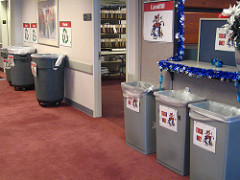 I sponsor an after-school science club for upper elementary students. They’d like to expand the recycling program at the school. I’m looking for suggestions on what they can do. – C., Pennsylvania
I sponsor an after-school science club for upper elementary students. They’d like to expand the recycling program at the school. I’m looking for suggestions on what they can do. – C., Pennsylvania
It may help to add a context to your students’ efforts. In a “garbology” lesson, the teacher collects the classroom trash for a week. Students weigh the contents and separate it (wearing gloves) into actual trash and recyclable materials such as paper, cans, bottles. They then weigh the recyclables. By extrapolating this to the number of classrooms in the school, they estimate how much trash was generated in their school and what percentage could be recycled. (See also the lessons in Teaching the Three R’s: Reduce, Reuse, Recycle in the March 2012 issue of Science & Children)
The amount of paper used in the school might be a good start for students’ efforts to reduce, reuse, and recycle. Teachers could save old handouts or outdated materials that were printed on one side. Students could put a box next to the copier for any “mistake” copies with blank sides. Students could then collect and cut the paper in halves or quarters for quizzes, notes, or practice work. This would be one last use before recycling the paper.
Do students drink from water bottles in the classroom? In addition to installing containers to recycle them, club members could begin an awareness program to encourage reusable bottles. (Bottles with the school logo could be a fund-raiser.)
Your members could be “recycling monitors” in their classrooms, reminding others to put materials that could be reused or recycled in the proper containers.
For more ideas, NSTA’s The Science Teacher features the monthly column The Green Room with suggestions on making classrooms and teaching more environmentally friendly. These ideas could be adapted for any level of students.
Photo: http://tinyurl.com/zro35su
Citizen science + Photos of signs in public spaces = literacy and spatial awareness
By Peggy Ashbrook
Posted on 2016-12-23
If you and the children need to be active to stay warm outdoors in cold temperatures, consider walking fast on a walking field trip to locate and document signs around your community. In the September 2011 issue of Science and Children I wrote about helping children understand what models are by taking a walking field trip to create a model (map) of the area around the school (Early Years column, A Sense of Place: Schoolyard as a Model). Using photographs taken by teachers, children matched each photo with the actual sign as they walked past it, and placed the photo on a paper map, locating the sign relative to other landmarks.
 Now there is a group of scientists who need help collecting photos of signs and lettering in public spaces so they can analyze the diversity and dynamics of public writing. Their project is called Lingscape – Linguistic Landscaping and the project uses an app to send the data. Your children can help collect this data while becoming more aware of the spatial relationships between street signs and other human infrastructure and the landscape. As children find and photograph signage, they can identify symbols and letters, sound out and read words. While they help scientists in another location study public writing, they can learn about how public writing is used in their community.
Now there is a group of scientists who need help collecting photos of signs and lettering in public spaces so they can analyze the diversity and dynamics of public writing. Their project is called Lingscape – Linguistic Landscaping and the project uses an app to send the data. Your children can help collect this data while becoming more aware of the spatial relationships between street signs and other human infrastructure and the landscape. As children find and photograph signage, they can identify symbols and letters, sound out and read words. While they help scientists in another location study public writing, they can learn about how public writing is used in their community.
Find out more about this and other such citizen science projects from the SciStarter website.
 I used the Lingscape–Linguistic Landscaping app to document signs and lettering in public spaces near the school and it worked well. Even young children can use digital cameras although teachers might have to crop their photos for clarity. The location services must be turned on to locate your photos automatically on the app’s map but you can set the location yourself if you prefer not to share location on the camera or phone.
I used the Lingscape–Linguistic Landscaping app to document signs and lettering in public spaces near the school and it worked well. Even young children can use digital cameras although teachers might have to crop their photos for clarity. The location services must be turned on to locate your photos automatically on the app’s map but you can set the location yourself if you prefer not to share location on the camera or phone.
Print copies of the photos for children to use in creating a class book about signs in the neighborhood. Young children may not immediately understand that the satellite photography or map base represents the landscape around them but they will enjoy discovering and documenting signs, and looking at examples uploaded from other locations, perhaps some they have visited, lived in, or have family living there.
If you and the children need to be active to stay warm outdoors in cold temperatures, consider walking fast on a walking field trip to locate and document signs around your community.
Feedback from participants
By Mary Bigelow
Posted on 2016-12-23
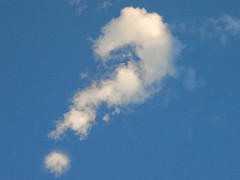 Recently, I did a hands-on workshop for other teachers on science apps and probes. I thought it went really well, and no one had any questions at the end of the session. But now, I’m getting lots of messages and phone calls for help. My colleague said that I must not have done a good job if there are so many questions. What did I do wrong? —T., Maryland
Recently, I did a hands-on workshop for other teachers on science apps and probes. I thought it went really well, and no one had any questions at the end of the session. But now, I’m getting lots of messages and phone calls for help. My colleague said that I must not have done a good job if there are so many questions. What did I do wrong? —T., Maryland
First of all, don’t beat yourself up. If the teachers have questions now, at least they’re trying to use what you introduced in the workshop. And it’s important they feel comfortable asking for your assistance. As you know from your own classroom, non-judgmental assistance can turn frustration into success.
When you asked for questions, perhaps the attendees were overloaded, ready to go home or back to the classroom. Or they felt comfortable with the apps at the time and thought they knew what they were doing. Now they’re unsure trying them without you and the others for immediate support. Some teachers are hesitant to introduce something new to students unless they are familiar with it themselves. They might need more encouragement, information, and feedback.
During future workshops, provide lots of modeling and practice time, even if you introduce fewer apps. Allow the attendees to make some mistakes and try to figure out a solution. I like to plan a follow-up session, either in person or online, to address teachers’ questions and for them to share their experiences.
Keep a record of the types of questions you’re asked. Use this feedback as you plan the next workshop (and please do so—it’s beneficial for teachers to learn from another teacher who can model the process.)
 Recently, I did a hands-on workshop for other teachers on science apps and probes. I thought it went really well, and no one had any questions at the end of the session. But now, I’m getting lots of messages and phone calls for help. My colleague said that I must not have done a good job if there are so many questions.
Recently, I did a hands-on workshop for other teachers on science apps and probes. I thought it went really well, and no one had any questions at the end of the session. But now, I’m getting lots of messages and phone calls for help. My colleague said that I must not have done a good job if there are so many questions.
Argument-Driven Inquiry in Physical Science
By Carole Hayward
Posted on 2016-12-23
Interested in teaching your students how to make and support their science explanations in the classroom? We’ve got just the thing. The newest books in the Argument-Driven Inquiry Series from NSTA Press is here.
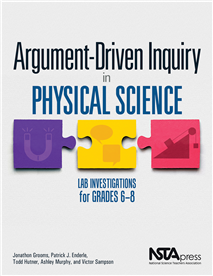 Argument-Driven Inquiry in Physical Science Lab Investigations for Grades 6-8 and the accompanying student manual offer 22 labs that align with the recommendations of A Framework for K-12 Science Education, as well as the Common Core State Standards for English Language Arts and Mathematics.
Argument-Driven Inquiry in Physical Science Lab Investigations for Grades 6-8 and the accompanying student manual offer 22 labs that align with the recommendations of A Framework for K-12 Science Education, as well as the Common Core State Standards for English Language Arts and Mathematics.
The labs provide students with the independence to investigate, analyze, and determine a conclusion. Labs include “Mass and Motion: How Do Changes in the Mass of an Object Affect Its Motion?” In the lab, students will study the motion of a pull cart to investigate what makes a system stable and what causes changes within a system, and then draw conclusions from patterns they observe.
The lab “Kinetic Energy: How Do the Mass and Velocity of an Object Affect Its Kinetic Energy?” asks students to use what they know about force and motion, patterns, and causal relationships to design and carry out an investigation and create a mathematical model explaining the relationship between mass, velocity, and force of impact.
With the argument-driven inquiry model students are asked to give presentations to their peers; respond to questions; and write, evaluate, and revise reports as part of each lab. The model is designed to be thought-provoking and multi-layered. Students must identify the task and guiding question, design a method and collect data, analyze data to develop an argument, and more.
“Each of the eight stages in the argument-driven inquiry instructional model is designed to ensure that the experience is authentic (students have an opportunity to engage in the practices of science) and educative (students receive the feedback and explicit guidance that they need to improve on each aspect of science proficiency),” the authors write in the first chapter.
Check out the free sample lab “Potential Energy: How Can You Make an Action Figure Jump Higher?” from Argument-Driven Inquiry in Physical Science: Lab Investigations for Grades 6-8 by Jonathon Grooms, Patrick J. Enderle, Todd Hutner, Ashley Murphy, and Victor Sampson.
You can also get the accompanying student lab manual for grades 6-8 here. Explore other books in the Argument-Driven Inquiry Series, including volumes focused on life science, biology, and chemistry.
Follow NSTA
Save
Interested in teaching your students how to make and support their science explanations in the classroom? We’ve got just the thing. The newest books in the Argument-Driven Inquiry Series from NSTA Press is here.



